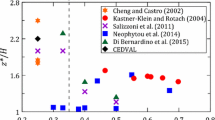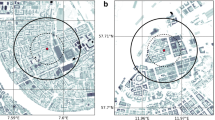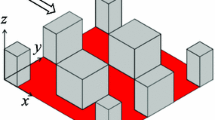Abstract
Air temperature and wind speed profiles measured during one year by means of a SODAR-RASS system located within a large park were examined for the urban boundary layer (UBL) over Rome, Italy. These data, combined with velocity and temperature measurements performed near the ground were used to analyze the vertical structure of the boundary layer and to estimate some turbulence parameters characterizing the surface layer. About 52,000 vertical profiles of wind speed and temperature were used for the analysis, allowing investigation for a large variety of stability conditions. First, friction velocity and Obukhov length were examined, showing clearly their dependence on the time of day and season. Second, the applicability of the Monin–Obukhov (MO) similarity theory—developed over rural terrain—was tested up to 200 m above ground level. For the wind speed profiles, the performance of the MO similarity degrades with both increasing height and stability, with maximum errors that are on the order of 300 % at 200 m for the most stable case. In contrast, for the air temperature the error always remains below 50 %.
Similar content being viewed by others
References
Nieuwstadt FTM, Duynkerke PG (1996) Turbulence in the atmospheric boundary layer. Atmos Res 40: 111–142
Roth M (2000) Review of atmospheric turbulence over cities. Q J R Meteorol Soc 126: 941–990
Foken T (2006) 50 years of Monin–Obukhov similarity theory. Boundary-Layer Meteorol 119: 431–447
Oke TR (1982) The energy basis of the urban heat island. Q J R Meteorol Soc 108: 1–24
Atkinson BJ (1985) UPDATE: the urban atmosphere. Cambridge University Press, Cambridge
Fernando HJS, Lee S-M, Anderson J, Princevac M, Pardyjak E, Grossman-Clarke S (2001) Urban fluid mechanics: air circulation and contaminant dispersion in cities. Environ Fluid Mech 1: 107–164
Britter RE, Hanna SR (2003) Flow and dispersion in urban areas. Annu Rev Fluid Mech 35: 469–496
Fernando HJS (2010) Fluid dynamics of urban atmospheres in complex terrain. Annu Rev Fluid Mech 42: 365–389
Arnfield AJ (2003) Two decades of urban climate research: a review of turbulence, exchanges of energy and water, and the urban heat island. Int J Climatol 23: 1–26
Mestayer PG, Durand P, Augustin P, Bastin S, Bonneford J-M et al (2005) The urban boundary layer field campaign in marseille (UBL/CLU_ESCOMPTE): set-up and first results. Boundary-Layer Meteorol 114: 315–365
Ellis NL, Middleton DR (2000) Field measurements and modeling of urban meteorology in Birmingham, UK. Met Office Turbulence and Diffusion Note No. 268. Met Office, Bracknell
Rantamaki M, Pohjola M, Kukkonen J, Karppinen A (2003) Evaluation of the HIRLAM model against meteorological data during an air pollution episode in southern Finland 27–29 December 1995. In: 4th conference on urban air quality, Hatfield, UK, 25–27 March 2003, pp 420–423
Ziomas IC (1998) The Mediterranean campaign of photochemical tracers-transport and chemical evolution (MED-CAPHOT-TRACE): an outline. Atmos Environ 32: 2045–2053
Baklanov A, Kuchin A (2004) The mixing height in urban areas—comparative study for Copenhagen. Atmos Chem Phys 4: 2839–2866
Nadeau DF, Brutsaert W, Parlange MB, Bou-Zeid E, Barrenetxea G, Couach O, Boldi M-O, Selker JS, Vetterli M (2009) Estimation of urban sensible heat flux using a dense wireless network of observations. Environ Fluid Mech 9: 635–653
Feigenwinter C, Vogt R, Parlow E (1999) Vertical structure of selected turbulence characteristics above an urban canopy. Theor Appl Climatol 62: 51–63
Emeis S, Münkel C, Vogt S, Müller WJ, Schäfer K (2004) Atmospheric boundary-layer structure from simultaneous SODAR, RASS and ceilometer measurements. Atmos Environ 38: 273–286
Rotach MW, Gryning SE, Batchvarova E, Christen A, Vogt R (2004) Pollutant dispersion close to an urban surface—the BUBBLE tracer experiment. Meteorol Atmos Phys 87: 39–56
Argentini S, Mastrantonio G, Lena F (1999) Case studies of the wintertime convective boundary-layer structure in the urban area of Milan, Italy. Boundary-Layer Meteorol 93: 253–267
Wood CR, Lacser A, Barlow JF, Padhra A, Belcher SE, Nemitz E, Helfter C, Famulari D, Grimmond CSB (2010) Turbulent flow at 190 m height above London during 2006–2008: a climatology and the applicability of similarity theory. Boundary-Layer Meteorol 137: 77–96
Barlow JF, von Rooney GG, Hünerbein S, Bradley SG (2008) Relating urban surface-layer structure to upwind terrain for the Salford Experiment (Salfex). Boundary-Layer Meteorol 127: 173–191
Gryning SE, Batchavarova E, Brummer B, Joergensen H, Larsen S (2007) On the extension of the wind profile over homogeneous terrain beyond the surface boundary layer. Boundary-Layer Meteorol 124: 251–268
Colacino M (1980) Some observations of the urban heat island in Rome during the summer season. Nuovo Cimento 3C: 165–179
Colacino M, Lavagnini A (1982) Evidence of the urban heat island in Rome by climatological analyses. Arch Meteorol Geophys Bioclimatol 31: 87–97
Palmieri S, delle Passeri L, Siani AM, Casale GR (2002) Temperatura, umidità e vento nella canopia urbana. In: Ecosistemi Urbani 182, Bardi Editore, Roma, pp 109–132
Bonacquisti V, Casale GR, Palmieri S, Siani AM (2006) A canopy layer model and its application to Rome. Atmos Environ 364: 1–13
Mastrantonio G, Viola A, Argentini S, Fiocco G, Giannini L, Rossini L, Abbate G, Ocone R, Casonato M (1994) Observations of sea breeze events in Rome and the surrounding area by a network of Doppler sodars. Boundary-Layer Meteorol 71: 67–80
Leuzzi G, Monti P (1997) Breeze analysis by Mast and Sodar Measurements. Nuovo Cimento C 20: 343–359
Castracane P, Selmi L, Casadio S, Cacciani M, Fiocci G (2001) Ground-based remote sensing of wind, temperature and aerosol backscattering in an urban environment during different atmospheric stability conditions. Phys Chem Earth B 26: 239–245
Petenko I, Mastrantonio G, Viola A, Argentini S, Coniglio L, Monti P, Leuzzi G (2011) Local circulation diurnal patterns and their relationship with large-scale flows in a coastal area of the Tyrrhenian Sea. Boundary-Layer Meteorol 139: 353–366
Caballero R, Lavagnini A (2002) A numerical investigation of the sea breeze and slope flows around Rome. Nuovo Cimento C 25: 287–304
Ferretti R, Mastrantonio G, Argentini S, Santoleri R, Viola A (2003) A model-aided investigation of winter thermally driven circulation on the Italian Tyrrhenian coast: a case study. J Geophys Res 108(D24): 4777
Monti P, Leuzzi G (2005) A numerical study of mesoscale airflow and dispersion over coastal complex terrain. Int J Environ Pollut 25: 239–250
Stull RB (1988) An introduction to boundary layer meteorology. Kluwer, Dordrecht
Brotzge JA, Crawford KC (2000) Estimating sensible heat flux from the Oklahoma Mesonet. J Appl Meteorol 39: 102–116
Holtslag AAM (1984) Estimates of diabatic wind speed profiles from near-surface weather observations. Boundary-Layer Meteorol 29: 225–250
Fernando HJS, Zajic D, Di Sabatino S, Dimitrova R, Hedquist B, Dallman A (2010) Flow, turbulence, and pollutant dispersion in urban atmospheres. Phys Fluids 22: 051301
Panofsky HA, Dutton JA (1984) Atmospheric turbulence. Wiley, New York
Hsieh C-I, Katul G, Chi T-w (2000) An approximate analytical model for footprint estimation of scalar fluxes in thermally stratified atmospheric flows. Adv Water Resour 23: 765–772
Paulson CA (1970) The mathematical representation of wind speed and temperature in the unstable atmospheric surface layer. J Appl Meteorol 9: 857–861
Businger JA, Wyngaard JC, Itzumi Y, Bradley EF (1971) Flux profile relationship in the atmospheric surface layer. J Atmos Sci 28: 181–189
Argentini S, Pietroni I, Gariazzo C, Amicarelli A, Mastrantonio G, Pelliccioni A, Petenko I, Viola A (2009) Boundary layer temperature profiles by a RASS a microwave radiometer. Differences, limits and advantages. Nuovo Cimento 124B: 549–564
Mahrt L (1998) Stratified atmospheric boundary layers and breakdown of models. Theor Comput Fluid Dyn 11: 263–279
Lee S-M, Fernando HJS, Princevac M, Zajic D, Sinesi M, McCulley JL, Anderson J (2003) Transport and diffusion of ozone in the nocturnal and morning boundary layer of the Phoenix valley. Environ Fluid Mech 3: 331–362
Zilitinkevich SS, Mammarella I, Baklanov AA, Joffre SM (2008) The effect of stratification on the aerodynamic roughness length and displacement height. Boundary-Layer Meteorol 129: 179–190
Zannetti P (1990) Air pollution modeling: theories, computational methods, and available software. Computational Mechanics Publications, New York
Pietri L, Petroff A, Amielh M, Anselmet F. (2009) Turbulence characteristics within sparse and dense canopies. Environ Fluid Mech 9: 297–320
Holton JR (2004) An introduction to dynamic meteorology. Elsevier Academic Press, Seattle
Karlsson S (1986) The applicability of wind profile formulas to an urban-rural interface site. Boundary-Layer Meteorol 34: 333–355
Author information
Authors and Affiliations
Corresponding author
Rights and permissions
About this article
Cite this article
Pelliccioni, A., Monti, P., Gariazzo, C. et al. Some characteristics of the urban boundary layer above Rome, Italy, and applicability of Monin–Obukhov similarity. Environ Fluid Mech 12, 405–428 (2012). https://doi.org/10.1007/s10652-012-9246-3
Received:
Accepted:
Published:
Issue Date:
DOI: https://doi.org/10.1007/s10652-012-9246-3




